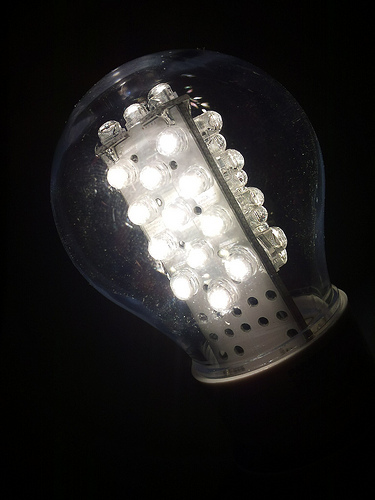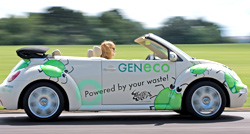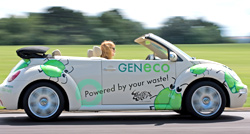 Prices for LED lightbulbs have dropped to $20.Photo: Flickr via kalleboo1. Bulb buster: Does Home Depot have a deal for you. One light bulb for $20. No, it really is a good deal because we’re talking about an LED bulb which could glow for 30 years. No one expected LEDs to break the $20 per bulb barrier so soon, but with federal guidelines coming in 2012 that will require much more efficient light bulbs, manufacturers want to start building an LED business — and that means lowering the price. Leslie Kaufman tells the tale in the New York Times.
Prices for LED lightbulbs have dropped to $20.Photo: Flickr via kalleboo1. Bulb buster: Does Home Depot have a deal for you. One light bulb for $20. No, it really is a good deal because we’re talking about an LED bulb which could glow for 30 years. No one expected LEDs to break the $20 per bulb barrier so soon, but with federal guidelines coming in 2012 that will require much more efficient light bulbs, manufacturers want to start building an LED business — and that means lowering the price. Leslie Kaufman tells the tale in the New York Times.
2. Wake and bake: The planet’s feeling like a crock pot these days, but let’s not rely on feelings. The numbers don’t lie. Heat records have been set in 17 countries this year. (That, itself, is a record — surpassing the previous high mark of 14). We know how steamy the summer’s been on the East Coast and how hellish it’s been in Russia, but temperatures in Iraq, Saudi Arabia, Niger, and Sudan have soared above 115 degrees. Pakistan, 20 percent of which is now under flood water, set a new record for all of Asia in May: a hair-toasting 128-degree day. Feel the heat with John Vidal in The Guardian.
3. There’s an app for that? Climate change deniers rarely miss a chance to, well, deny science. So it was just a matter of time before they went mobile with their special brand of snake oil. A new iPhone app now explains why we’re really not causing global warming, everything is fine, and we should all just go out and buy a Hummer. Ben Geman of The Hill has the story.
4. Oversight unseen: Should we be surprised when we hear about more stumbling and bumbling by the federal regulators overseeing deepwater wells in the Gulf of Mexico? Probably not. But still, it was a bit of a shocker to find out, during a hearing of the National Academy of Engineering, that federal inspectors mistakenly assumed that other agencies had certified Gulf drilling rigs. Learn more from Matthew Wald in the New York Times Green blog.
5. Time marches on … and on: Okay, so you can’t afford a hybrid car at the moment. But you can still do your part for clean energy, and for a whole lot less. Later this month, Seiko will introduce a solar clock. It’s not the first such hybrid timepiece, but it will be the most efficient. If you keep it in a well-lit room, Seiko insists the clock will keep running for four years. (Promise does not apply if you throw clocks across room.) Rick Martin, of Gizmag, fills in the details.
6. That old black magic: It’s time to start treating that bag of charcoal in the garage with a little more respect. According to a recent study, burying charcoal could become an effective way to help reduce greenhouse gases. We’ve long known that by turning plant life into charcoal we keep it from releasing CO2 into the atmosphere when it dies. The new study finds that buried charcoal also interacts with the soil to reduce the level of greenhouse gases methane and nitrous oxide being released into the atmosphere. David Biello has the lowdown on charcoal’s magical powers in Scientific American.
7. Green as we wannabe: A new poll suggests that both corporate execs and consumers still doubt that the business community is serious about going green. According to the 2010 Gibbs & Soell Sense and Sustainability Study, only 29 percent of Fortune 1000 execs — and a mere 16 percent of consumers — surveyed think the majority of companies are committed to adopting environmentally-friendly business practices. The biggest perceived hurdle to greener practices? Lack of return on investment. GreenBiz.com has more.
8. My way or the fry way: With a global strategy for addressing climate change now looking as likely as hair on snakes, it will be tempting for countries to go their own way. And that could mean turning to geo-engineering techniques to cool their climates. We’re talking about things like solar radiation management, where you shoot aerosols into the atmosphere to create clouds or erect giant mirrors to reflect the sun away from the Earth. But a team of scientists from Carnegie Mellon and Oxford Universities says such practices are likely to end badly. Their research suggests that quick fixes for global warming in one region will only cause problems elsewhere. Go deeper with The Ecologist.
9. Leader of the pack: Even something as airy as Styrofoam can leave a heavy carbon footprint, so a round of applause for Ecovative Design (yes, that’s really how you spell it), a New York-based company that has created a packing material out of mushroom roots and agricultural waste. By treating their packing product with natural oils such as thyme, oregano, and lemongrass, the Ecovative process uses 98 percent less energy than styrofoam manufacturers. GreenerDesign has more.
 This car is full of shit.Photo: Geneco10. Fart your engines: And while we’re handing out kudos, here’s one for a British company named GENeco, which has devised a way to run a car on the ultimate renewable fuel: human waste. GENenco teamed up with Volkswagen on the “Bio-Bug,” a poop-powered ride that can hit 114 mph. Keep eating fiber. Alyssa Danigelis clears up the messy details at Discovery News.
This car is full of shit.Photo: Geneco10. Fart your engines: And while we’re handing out kudos, here’s one for a British company named GENeco, which has devised a way to run a car on the ultimate renewable fuel: human waste. GENenco teamed up with Volkswagen on the “Bio-Bug,” a poop-powered ride that can hit 114 mph. Keep eating fiber. Alyssa Danigelis clears up the messy details at Discovery News.



